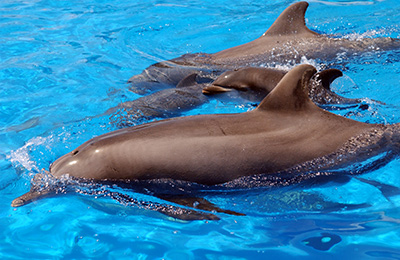Gestation
The gestation period is about 12 months.

Birth
Worldwide, calves are born throughout the year. Birthing season is dependent on geographical location. Births may occur in all seasons, but typically peaks occur during spring, early summer and fall.
Seasonal calving peaks vary by area.
- Dolphin births off the coast of Sarasota, Florida occur in late spring to early summer. A secondary peak occurs in early autumn.
- In waters along the central U.S. Atlantic coast, the prolonged calving season shows a spring peak.
- Peak calving for dolphins in Florida's Indian River Lagoon occurs in April and August.
- Most dolphin births along coastal Texas waters occur in March.
- Bottlenose dolphins in the Pacific Ocean along the coast of Southern California have shown a calving peak in the fall.
- In Patagonia and South Africa, births peak in summer.
Frequency of birth
A female dolphin can potentially bear a calf every two years, but calving intervals generally average three years. Bottlenose dolphins have a three to six years calf interval in Sarasota Bay, Florida.

Calving
Calves are born in the water. Deliveries are usually tail-first, but head-first deliveries are also seen. The umbilical cord snaps during delivery.
Sometimes an assisting dolphin may stay close to the new mother and calf. Although this assisting dolphin often is referred to as an "auntie" dolphin, it may be male or female. This auntie dolphin is often the only other dolphin a mother allows near her calf.

Calf at Birth
Calves are approximately 111 to 116.3 cm (43.7 to 45.7 in.) long and weigh about 10 to 20 kg (22 to 44 lbs.).
In the first few days after birth, the calf's dorsal fin and tail flukes are pliable and lack firmness, but gradually stiffen.
Calves, darker than adults, show several vertical, light lines on their sides, a result of fetal folding. These lines disappear within six months.

Care of Young
Nursing.
- A calf may nurse for up to 18 to 24 months. The maximum nursing period observed was seven years in Sarasota Bay, Florida, and may serve as a bonding activity.
- Calves nurse below water, close to the surface. The calf suckles from nipples concealed in abdominal mammary slits.
-
Observations in zoological parks show that nursing usually begins within 6 hours of birth. A calf nurses as often as 4 times per hour for the first 4 to 8 days.
-
Each nursing instance usually lasts only about 5 to 10 seconds. A calf nurses 3 to 8 times per hour throughout the day and night.
-
Milk is composed of 33% fat, 6.8% protein, and 58% water, with traces of lactose. The rich milk helps the baby rapidly develop a thick blubber layer.

In caring for her calf, a mother dolphin stays close by and attentively directs the calf's movements.
- The calf is carried in the mother's "slipstream," the hydrodynamic wake that develops as the mother swims. This helps the baby swim and enables the mother and calf to stay up with the group.
There is probably a considerable amount of learning involved in mothering.
Calf Development
Bottlenose dolphin breeding colonies in marine zoological parks continue to provide a unique opportunity to observe and quantify dolphin reproductive biology.
In zoological environments, calves begin to take a few fish at about 3 to 4 months when their teeth begin to erupt. Calves begin to eat fish when they reach about 130 to 150 cm (51 to 59 in.).
Within a few days of birth a calf can vocalize, but signature characteristics develop with age.
Mother-calf bonds are long-lasting; a calf typically stays with its mother 3 to 6 years. The dependency period of calves in zoological facilities is much shorter because the animals are not vulnerable to predation, do not have to learn foraging techniques, and are well fed.


Births at SeaWorld and Discovery Cove
SeaWorld has one of the most successful breeding programs for bottlenose dolphins in the world. More than 85% of the bottlenose dolphin calves at SeaWorld were born at one of the SeaWorld parks or at Discovery Cove.
- Since 2003, many of the bottlenose dolphin calves born at SeaWorld are the result of artificial insemination techniques. Artificial insemination helps SeaWorld maintain their dolphins' genetic diversity without having to move them from park to park.
- In 2005, the world's first sex-selected bottlenose dolphin was born at SeaWorld San Diego.
- This was the first time researchers were able to select the sex of any type of zoological species prior to conception through the use of artificial insemination technologies. This scientific advancement affords zoological institutions around the globe the opportunity to manage their species' genetic diversity.
- The techniques and knowledge gained from this advancement can be applied to other cetaceans, mammals and terrestrial animals in the wild, including endangered species.




